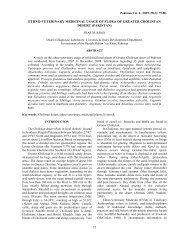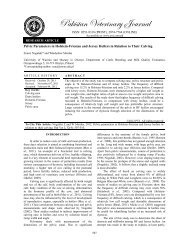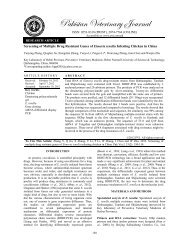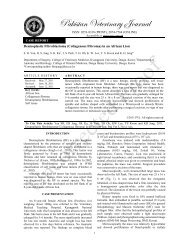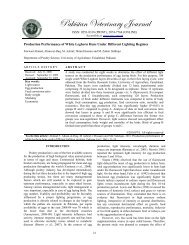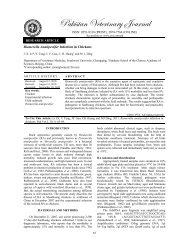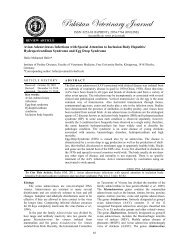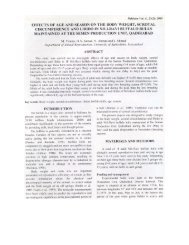Documentation of Ethnoveterinary Practices for Mastitis in Dairy ...
Documentation of Ethnoveterinary Practices for Mastitis in Dairy ...
Documentation of Ethnoveterinary Practices for Mastitis in Dairy ...
You also want an ePaper? Increase the reach of your titles
YUMPU automatically turns print PDFs into web optimized ePapers that Google loves.
Pakistan Veter<strong>in</strong>ary Journal<br />
ISSN: 0253-8318 (PRINT), 2074-7764 (ONLINE)<br />
Accessible at: www.pvj.com.pk<br />
<strong>Documentation</strong> <strong>of</strong> <strong>Ethnoveter<strong>in</strong>ary</strong> <strong>Practices</strong> <strong>for</strong> <strong>Mastitis</strong> <strong>in</strong> <strong>Dairy</strong> Animals <strong>in</strong> Pakistan<br />
S. M. Raihan Dilshad, N. U. Rehman*, Nazir Ahmad and A. Iqbal 1<br />
Department <strong>of</strong> Theriogenology; 1 Department <strong>of</strong> Livestock Management, University <strong>of</strong> Agriculture, Faisalabad, Pakistan<br />
*Correspond<strong>in</strong>g author: rehmannajib@yahoo.com<br />
ARTICLE HISTORY<br />
Received:<br />
Revised:<br />
Accepted:<br />
September 08, 2009<br />
September 20, 2009<br />
October 01, 2009<br />
Key words:<br />
Buffalo<br />
Cattle<br />
<strong>Ethnoveter<strong>in</strong>ary</strong> practices<br />
<strong>Mastitis</strong><br />
ABSTRACT<br />
This study was aimed to document the ethnoveter<strong>in</strong>ary practices (EVPs) used <strong>for</strong><br />
the control and treatment <strong>of</strong> mastitis <strong>in</strong> cattle and buffaloes <strong>in</strong> the Sargodha district,<br />
Pakistan. The <strong>in</strong><strong>for</strong>mation was collected us<strong>in</strong>g rapid and participatory rural<br />
appraisal techniques through <strong>in</strong>terviews and focused group discussions with 217<br />
traditional veter<strong>in</strong>ary healers (TVHs) over a period <strong>of</strong> 16 months from September<br />
2005 to December 2006. Thus, 25 different plant species belong<strong>in</strong>g to 20 different<br />
families were documented from the study area <strong>for</strong> the treatment and prophylaxis <strong>of</strong><br />
mastitis <strong>in</strong> bov<strong>in</strong>es (cattle) and bubal<strong>in</strong>es (dairy buffalo, Bubalus bubalis). The<br />
most frequently reported (≥10 times) plant species were Capsicum annuum L. (n =<br />
32), Lepidium sativum L. (n =31), Allium sativum L. (n = 28), Sesamum <strong>in</strong>dicum L.<br />
(n = 24), Citrus limon (L.) Burm. f (n = 22), Z<strong>in</strong>giber <strong>of</strong>fic<strong>in</strong>ale Roscoe (n = 18),<br />
Citrullus colocynthis (L.) Schrad (n = 18), Curcuma longa L. (n = 16), Cum<strong>in</strong>um<br />
cym<strong>in</strong>um L. (n = 14), Rosa <strong>in</strong>dica L. (n = 13), Centratherum anthelmisticum L. (n<br />
= 12), Triticum aestivum L (n = 11), Nigella sativa L. (n = 11) and Peganum<br />
harmala L. (n = 11). All the documented plant species were <strong>in</strong>digenous to the<br />
study area. Materials other than plants used <strong>for</strong> the treatment <strong>of</strong> this problem<br />
<strong>in</strong>cluded ammonium chloride. The richness <strong>of</strong> EVPs <strong>in</strong> the study area and<br />
extensive variation <strong>in</strong> the doses, methods <strong>of</strong> preparation, <strong>in</strong>dications, and claims<br />
regard<strong>in</strong>g efficacy <strong>of</strong> plants <strong>for</strong> mastitis merit controlled studies <strong>for</strong> their<br />
validation.<br />
©2010 PVJ. All rights reserved<br />
To cite this article: Dilshad SMR, NU Rehman, N Ahmad and A Iqbal, 2010. <strong>Documentation</strong> <strong>of</strong> ethnoveter<strong>in</strong>ary<br />
practices <strong>for</strong> mastitis <strong>in</strong> dairy animals <strong>in</strong> Pakistan. Pak Vet J, 30(3): 167-171.<br />
INTRODUCTION<br />
Pakistan is one <strong>of</strong> the major dairy<strong>in</strong>g countries <strong>in</strong> the<br />
world with a population <strong>of</strong> over 29 millions heads <strong>of</strong> dairy<br />
buffalo (Bubalus bubalis) and 31.8 million heads <strong>of</strong> cattle.<br />
This huge number <strong>of</strong> cattle and buffaloes, however,<br />
produce only 30 million tons <strong>of</strong> milk per annum<br />
(Economic Survey <strong>of</strong> Pakistan, 2007-2008), which<br />
translates <strong>in</strong>to 2-3 liters <strong>of</strong> milk production per animal per<br />
day. Poor genetic potential and nutritional and<br />
managemental practices, especially those affect<strong>in</strong>g the<br />
health <strong>of</strong> milk produc<strong>in</strong>g organ (udder) are the major<br />
factors <strong>for</strong> low milk production <strong>in</strong> these animals (Yousaf,<br />
2009).<br />
<strong>Mastitis</strong> is the outcome <strong>of</strong> a complex <strong>in</strong>teraction<br />
between host (cows, buffaloes etc.), causative agents<br />
(microorganisms) and environment (Muhammad and<br />
Firyal, 2008) and is the most costly disease <strong>of</strong> the dairy<br />
<strong>in</strong>dustry all over the world (DeGraves and Fetrow, 1993;<br />
Allert, 1995). It globally leads to losses <strong>of</strong> 53 billion<br />
dollars annually (Ratafia, 1987). In various surveys,<br />
167<br />
mastitis has been identified as the major livestock<br />
problem <strong>of</strong> Pakistan (Cady et al., 1983; Hussa<strong>in</strong> et al.,<br />
2005; Ali, 2006; Muhammad and Firyal, 2008). Among<br />
various microorganisms, bacteria (Staphylococcus aureus<br />
and Streptococcus agalactiae) have been reported to be<br />
the most commonly associated etiological agents <strong>of</strong><br />
mastitis <strong>in</strong> dairy buffaloes and cows <strong>in</strong> Pakistan (Shakoor,<br />
2006). The commonly practiced antibiotic treatment <strong>for</strong><br />
the cure <strong>of</strong> the cl<strong>in</strong>ical mastitis denotes poor results<br />
(Sandholm et al., 1990). Failure <strong>of</strong> the antibiotics to reach<br />
the site <strong>of</strong> <strong>in</strong>fection <strong>in</strong> adequate concentrations,<br />
development <strong>of</strong> resistance to antibiotics, bacterial<br />
dormancy, L-<strong>for</strong>m <strong>of</strong> bacteria (which are not sensitive to<br />
the β-lactam type <strong>of</strong> antibiotics), detrimental nature <strong>of</strong><br />
some antibiotics to phagocytosis and <strong>in</strong>compatibility <strong>of</strong><br />
antibacterial with milk have been implicated <strong>for</strong> sub<br />
optimal results <strong>in</strong> the therapy <strong>of</strong> mastitis with antibiotics<br />
(Yousaf, 2009).<br />
The use <strong>of</strong> ethnoveter<strong>in</strong>ary medic<strong>in</strong>e (EVM) may<br />
present a cheaper and susta<strong>in</strong>able alternative to synthetic<br />
medic<strong>in</strong>es. These herbal preparations, draw<strong>in</strong>g upon
centuries <strong>of</strong> traditional belief and use, are <strong>in</strong> practice over<br />
time by pastoralists and farmers <strong>for</strong> the treatment <strong>of</strong><br />
different diseases <strong>of</strong> livestock (Danø and Bøgh, 1999).<br />
Natural products may also be an important source <strong>for</strong> new<br />
pharmaceuticals (Abelson, 1990). In Pakistan, Sargodha<br />
district is renowned <strong>for</strong> its high yield<strong>in</strong>g dairy animals and<br />
richness <strong>of</strong> ethnovetr<strong>in</strong>ary practices (Dilshad et al., 2008).<br />
The present study was carried out to document the use <strong>of</strong><br />
ethnoveter<strong>in</strong>ary practices <strong>for</strong> the treatment and control <strong>of</strong><br />
mastitis <strong>of</strong> cattle and buffaloes, the two most important<br />
dairy animals <strong>of</strong> Pakistan.<br />
MATERIALS AND METHODS<br />
Study area<br />
District Sargodha is located at latitude <strong>of</strong> 32.08 0 N and<br />
72.67 0 E <strong>of</strong> Punjab, Pakistan. The area under study<br />
comprises 5854 Km 2 and is divided <strong>in</strong>to 845 villages.<br />
Average ra<strong>in</strong>fall <strong>in</strong> the area is 526 mm/annum and mean<br />
temperature oscillates between 16.6 0 C <strong>in</strong> January and<br />
48 0 C <strong>in</strong> June (Pakistan Meteorological Department,<br />
2007). Sargodha is a canal irrigated pla<strong>in</strong> agricultural<br />
district with wheat, rice and sugarcane be<strong>in</strong>g its ma<strong>in</strong><br />
crops. The human population <strong>of</strong> district Sargodha is 2.8<br />
million (Population Census Organization, 1998) with a<br />
population density <strong>of</strong> 455 Km −2 . The population <strong>of</strong> cattle<br />
and buffaloes <strong>in</strong> the area has been estimated at 574,887<br />
and 687,685 heads, respectively (Economic Survey <strong>of</strong><br />
Pakistan, 2007-2008). The female animals are ma<strong>in</strong>ly<br />
used <strong>for</strong> milk production, while males are reared <strong>for</strong><br />
draught and meat purposes. Agriculture is the ma<strong>in</strong> source<br />
<strong>for</strong> <strong>in</strong>come <strong>of</strong> most <strong>of</strong> the people, who have a rich history<br />
<strong>of</strong> traditional livestock farm<strong>in</strong>g. There are 60 government<br />
veter<strong>in</strong>ary hospitals and/or dispensaries <strong>in</strong> the study area<br />
with a technical staff <strong>of</strong> 35 veter<strong>in</strong>ary <strong>of</strong>ficers and 102<br />
veter<strong>in</strong>ary assistants (Livestock and <strong>Dairy</strong> Development<br />
Department, 2007).<br />
Data collection<br />
The study comprised <strong>of</strong> three ma<strong>in</strong> steps. An <strong>in</strong>itial<br />
survey, rapid rural appraisal (RRA; Catley and<br />
Mohammed, 1996; Lans and Brown, 1998a) was<br />
conducted from September 2005 to December 2006 to<br />
identify the well-known traditional veter<strong>in</strong>ary healers<br />
(TVHs). Survey team comprised a Veter<strong>in</strong>arian who was<br />
well versed with the diseases <strong>of</strong> livestock and local<br />
language, a Veter<strong>in</strong>ary Assistant from nearby Veter<strong>in</strong>ary<br />
Hospital and a community leader from the local village. A<br />
purposive sampl<strong>in</strong>g <strong>of</strong> TVHs was made (Lans and Brown,<br />
1998b). Initial survey led to the identification <strong>of</strong> 217<br />
TVHs, which were the key respondents <strong>for</strong> collection <strong>of</strong><br />
subsequent <strong>in</strong><strong>for</strong>mation. The age <strong>of</strong> these TVHs ranged<br />
from 40 to 90 years and they enjoyed a respectable status<br />
<strong>in</strong> the community. They had ga<strong>in</strong>ed ethnoveter<strong>in</strong>ary<br />
knowledge through verbal transmission from their<br />
ancestors, by exchange <strong>of</strong> views dur<strong>in</strong>g the treatment <strong>of</strong><br />
animals with their coexist<strong>in</strong>g practitioners or through<br />
hands-on experience. Moreover, 35 veter<strong>in</strong>ary <strong>of</strong>ficers<br />
and 102 veter<strong>in</strong>ary assistants were also <strong>in</strong>cluded <strong>in</strong><br />
discussion.<br />
Interviews, focused group discussions and field visits<br />
were used as the tools <strong>of</strong> participatory rural appraisal<br />
(PRA). The <strong>in</strong><strong>for</strong>mation regard<strong>in</strong>g the treatment and<br />
168<br />
Pak Vet J, 2010, 30(3): 167-171.<br />
control <strong>of</strong> mastitis <strong>in</strong> cows and buffaloes us<strong>in</strong>g plants or<br />
other materials was collected us<strong>in</strong>g a well-structured<br />
questionnaire, open-ended <strong>in</strong>terviews and guided dialogue<br />
techniques. Focused group discussions were arranged <strong>for</strong><br />
verify<strong>in</strong>g the <strong>in</strong><strong>for</strong>mation provided by the TVHs to reach<br />
more accurate results. TVHs were asked to tell how they<br />
acquired the knowledge related to the disease diagnosis<br />
and treatment. They were also asked to show the plant<br />
species or other materials, if any, described <strong>for</strong> the<br />
treatment <strong>of</strong> mastitis <strong>in</strong> cows and buffaloes.<br />
All plants and other materials commonly used by<br />
TVHs <strong>for</strong> the treatment and control <strong>of</strong> mastitis were<br />
procured/ purchased from the area by the survey team.<br />
Medic<strong>in</strong>al plants used by the TVHs were identified by the<br />
Botany Department, University <strong>of</strong> Agriculture, Faisalabad<br />
(Pakistan) and the voucher specimens were preserved <strong>in</strong><br />
<strong>Ethnoveter<strong>in</strong>ary</strong> Research and Development Center,<br />
Faculty <strong>of</strong> Veter<strong>in</strong>ary Science, University <strong>of</strong> Agriculture,<br />
Faisalabad, Pakistan.<br />
RESULTS AND DISCUSSION<br />
Detailed discussion with TVHs, qualified veter<strong>in</strong>ary<br />
<strong>of</strong>ficers (35) and veter<strong>in</strong>ary assistants (102) resulted <strong>in</strong> the<br />
documentation <strong>of</strong> 25 different plant species belong<strong>in</strong>g to<br />
20 families (Table 1) and one other-than-plant material<br />
(ammonium chloride) be<strong>in</strong>g used <strong>for</strong> the treatment and<br />
control <strong>of</strong> mastitis <strong>in</strong> cows and buffaloes <strong>in</strong> the study area.<br />
Maximum number <strong>of</strong> plant species belonged to the family<br />
Poaceae and Z<strong>in</strong>giberaceae (n = 3 each), followed by<br />
Brassicaceae (n = 2). The most frequently reported (≥10<br />
times) plant species were Capsicum annuum L. (n = 32),<br />
Lepidium sativum L. (n =31), Allium sativum L. (n = 28),<br />
Sesamum <strong>in</strong>dicum L. (n = 24), Citrus limon (L.) Burm.f (n<br />
= 22), Z<strong>in</strong>giber <strong>of</strong>fic<strong>in</strong>ale Roscoe (n = 18), Citrullus<br />
colocynthis (L) Schrad (n = 18), Curcuma longa L. (n =<br />
16), Cum<strong>in</strong>um cym<strong>in</strong>um L. (n = 14), Rosa <strong>in</strong>dica L. (n =<br />
13), Centratherum anthelmisticum L. (n = 12), Triticum<br />
aestivum L (n = 11), Nigella sativa L. (n = 11) and<br />
Peganum harmala L. (n = 11). Most <strong>of</strong> the plant species<br />
documented <strong>in</strong> this survey were locally cultivated which<br />
is <strong>in</strong> accordance to the argument <strong>of</strong> Johns et al. (1990)<br />
that more common a plant <strong>in</strong> the area, the more <strong>of</strong>ten it<br />
would be used.<br />
The ethnoveter<strong>in</strong>ary practices (EVPs) recorded <strong>in</strong> this<br />
survey were be<strong>in</strong>g used as prophylactic and treatment<br />
measures by the TVHs. The third most frequently used<br />
plant <strong>for</strong> the treatment <strong>of</strong> mastitis was Allium sativum L.<br />
Two major objectives <strong>in</strong> the control <strong>of</strong> mastitis i.e. the<br />
prevention <strong>of</strong> new <strong>in</strong>fection and reduction <strong>in</strong> the duration<br />
<strong>of</strong> exist<strong>in</strong>g <strong>in</strong>fection (Muhammad and Firyal, 2008) may<br />
have been achieved by the antiseptic and vermifuge<br />
properties <strong>of</strong> the Allium sativum (Bullitta et al., 2007).<br />
Brassica campestris L. oil recorded <strong>for</strong> the treatment <strong>of</strong><br />
mastitis is <strong>in</strong> accordance with the report <strong>of</strong> Karreman<br />
(2007), who documented its use <strong>in</strong> treat<strong>in</strong>g mastitis along<br />
with the other plant materials. Citrullus colocynthis (L.)<br />
Schrad, reported to be used <strong>for</strong> controll<strong>in</strong>g mastitis <strong>in</strong> this<br />
study, has been used as galactagogue <strong>in</strong> India (Takhar,<br />
2004). The documentation <strong>of</strong> the usage <strong>of</strong> Curcuma longa<br />
<strong>for</strong> treat<strong>in</strong>g mastitis <strong>in</strong> this study is supported by the<br />
earlier report <strong>of</strong> its use <strong>in</strong> treat<strong>in</strong>g subcl<strong>in</strong>ical mastitis<br />
(Saxena et al., 1995). L<strong>in</strong>um usitatissimum L. has been
169<br />
Pak Vet J, 2010, 30(3): 167-171.<br />
Table 1: Frequency <strong>of</strong> use <strong>of</strong> medic<strong>in</strong>al plants <strong>for</strong> the treatment and control <strong>of</strong> mastitis <strong>in</strong> district Sargodha,<br />
Pakistan<br />
Plant family Plant species Vernacular name Frequency (n = 217)<br />
Alliaceae Allium sativum L. Lehson/thoom 28<br />
Apiaceae Foeniculum vulgare Mill. Saunf 08<br />
Asteraceae Cum<strong>in</strong>um cym<strong>in</strong>um L. Sufaid zeera 14<br />
Brassicaceae Lepidium sativum L. Halia 31<br />
Brassicaceae Brassica campestris L. Sarsson 04<br />
Capparidaceae Capparis deciduas (Forssk.) Edgew. Karir or Dillay 01<br />
Compositae Centratherum anthelmisticum L. Kali Zeeri 12<br />
Cucurbitaceae Citrullus colocynthis (L.) Schrad. Indryan/Kor tuma 18<br />
L<strong>in</strong>aceae L<strong>in</strong>um usitatissimum L. Alsi 05<br />
Malvaceae Gossypium hirsutum L. Paiway/waraiwa<strong>in</strong> 09<br />
Papilionaceae Trigonella foenumgraceum L Matheray 07<br />
Pedaliaceae Sesamum <strong>in</strong>dicum L. Meetha tael 24<br />
Poaceae Triticum aestivum L. Gandam/kanak 11<br />
Poaceae Oryza sativa L. Chawal/Moonji 10<br />
Poaceae Saccharum <strong>of</strong>fic<strong>in</strong>arum L. Kamad 08<br />
Polygonaceae Polygonum bistorta L. Anjbar 04<br />
Ranunculaceae Nigella sativa L. Kaoolnji 11<br />
Rosaceae Rosa <strong>in</strong>dica L. Gulab 13<br />
Rubiaceae Galium apar<strong>in</strong>eL. Banafsha 01<br />
Rutaceae Citrus limon (L.) Burm.f Khatian 22<br />
Solanaceae Capsicum annuum L. Lal mirch 32<br />
Z<strong>in</strong>giberaceae Z<strong>in</strong>giber <strong>of</strong>fic<strong>in</strong>ale Roscoe Sund 18<br />
Z<strong>in</strong>giberaceae Curcuma longa L. Haldi 16<br />
Z<strong>in</strong>giberaceae Amomum subulatum Roxb. Baree Ilaichee 03<br />
Zygophyllaceae Peganum harmala L. Harmal 11<br />
reported to be used as galactagogue <strong>in</strong> Bangladesh (Islam<br />
and Kashem, 1999). Trigonella foenumgraceum L.<br />
documented <strong>in</strong> the present study was also reported to be<br />
used <strong>in</strong> Southern region <strong>of</strong> Italy as remedy <strong>in</strong> various<br />
conditions related to the production <strong>of</strong> dairy products<br />
from dairy animals (Pieroni et al., 2004).<br />
Use <strong>of</strong> different parts <strong>of</strong> the plants (seeds, leaves,<br />
pulp from the stem, flowers, bark, oil extract, fruit, roots,<br />
petals, v<strong>in</strong>e and rhizome) <strong>for</strong> the treatment and control <strong>of</strong><br />
mastitis <strong>in</strong> cows and buffaloes has been depicted <strong>in</strong> Table<br />
2. In some cases, whole plant was used as a remedy. Some<br />
prescriptions documented <strong>in</strong> this study were based on a<br />
comb<strong>in</strong>ation <strong>of</strong> different plants with the understand<strong>in</strong>g<br />
that synergistic effect <strong>of</strong> different species <strong>of</strong> plants<br />
improved the cure rates. This argument was strengthened<br />
by the previous report <strong>of</strong> Bonet and Valles (2007).<br />
Variation <strong>in</strong> the effects <strong>of</strong> various plants was attributed to<br />
the qualitative and quantitative differences <strong>in</strong> biochemical<br />
constituents <strong>of</strong> the plants like phenolics, polyphenols,<br />
terpenoids, essential oils, alkaloids, lect<strong>in</strong>s and<br />
polypeptides (Cowan, 1999). The plant genotype (Scalzo<br />
et al., 2005) and agronomic practices (Hakk<strong>in</strong>en and<br />
Torronen, 2000) have been reported to affect the total<br />
phenolic and flavonoid contents <strong>in</strong> the fruit. Moreover, the<br />
degree <strong>of</strong> maturity at harvest, environmental conditions,<br />
development stages <strong>of</strong> the plant at harvest<strong>in</strong>g, dry<strong>in</strong>g<br />
process and storage technique (Croom, 1983;<br />
Zadernowski et al., 2005) can also trigger variations <strong>in</strong> the<br />
active compounds <strong>of</strong> plants.<br />
Commonly used vehicles <strong>for</strong> adm<strong>in</strong>istration <strong>of</strong> plant<br />
material <strong>in</strong>cluded water, jaggery, wheat flour, milk whey,<br />
butter as such or <strong>in</strong> ref<strong>in</strong>ed <strong>for</strong>m (desi ghee), sugar,<br />
vegetable oil, common and black salt. Sometimes milk<br />
(preferably cow milk) was used as a vehicle <strong>for</strong> the<br />
adm<strong>in</strong>istration <strong>of</strong> fruit <strong>of</strong> Amomum subulatum Roxb and<br />
leaves <strong>of</strong> Rosa <strong>in</strong>dica L. Similarly, saltish milk whey was<br />
mixed <strong>in</strong> oil extract <strong>of</strong> Sesamum <strong>in</strong>dicum <strong>in</strong> treat<strong>in</strong>g<br />
mastitis. It has been suggested that the use <strong>of</strong> such<br />
vehicles may dilute or reduce the relative potency <strong>of</strong> the<br />
drug (Jabbar et al., 2006).<br />
The survey identified a range <strong>of</strong> doses <strong>of</strong> the same<br />
plant used <strong>for</strong> same condition by different TVHs. Nonstandardized<br />
dosages (Longuefosse and Noss<strong>in</strong>, 1996) are<br />
subjected to criticism by the veter<strong>in</strong>arians (Niwa et al.,<br />
1991). The method <strong>of</strong> drug preparation <strong>in</strong> many cases<br />
varied from <strong>in</strong>dividual to <strong>in</strong>dividual. The same plant<br />
material <strong>for</strong> the same ailment was prepared <strong>in</strong> different<br />
ways by different TVHs. The commonly used methods <strong>for</strong><br />
preparation <strong>of</strong> plants and other materials to be used <strong>in</strong><br />
EVM were, gr<strong>in</strong>d<strong>in</strong>g, crush<strong>in</strong>g, mix<strong>in</strong>g, gr<strong>in</strong>d<strong>in</strong>g with<br />
sugar and preparation <strong>of</strong> a decoction <strong>in</strong> water, milk or<br />
some vegetable oil (preferably Brassica campestris oil).<br />
Sometimes, the fruit was cut <strong>in</strong> to pieces, common salt<br />
was poured on these cut pieces and they were put <strong>in</strong> open<br />
air <strong>for</strong> whole <strong>of</strong> the night, so that they became condensed<br />
with dew drops and then these were orally fed to cattle<br />
and buffaloes <strong>for</strong> solv<strong>in</strong>g the problem <strong>of</strong> mastitis. The<br />
material <strong>in</strong> this end was the fruit <strong>of</strong> Citrus limon.<br />
The commonly used modes <strong>of</strong> adm<strong>in</strong>istration were<br />
feed<strong>in</strong>g and drench<strong>in</strong>g. Sometimes the plant material was<br />
put on the fired hay to produce fumigations. These<br />
fumigations were applied to the affected quarters <strong>of</strong> the<br />
animal. The plant material <strong>in</strong> this end <strong>in</strong>cluded Peganum<br />
harmala and stem crush<strong>in</strong>g <strong>of</strong> Triticum sativum. Similar<br />
types <strong>of</strong> practices with different plant species have already<br />
been reported <strong>for</strong> treat<strong>in</strong>g mastitis <strong>in</strong> camels <strong>in</strong> Saudi
170<br />
Pak Vet J, 2010, 30(3): 167-171.<br />
Table 2: <strong>Ethnoveter<strong>in</strong>ary</strong> practices <strong>for</strong> the treatment and control <strong>of</strong> mastitis <strong>in</strong> district Sargodha, Pakistan<br />
Plants Part <strong>of</strong> the plant<br />
used<br />
Adm<strong>in</strong>istration / dosage <strong>for</strong> cows/buffaloes<br />
Allium sativum L. Rhizome 250g, gr<strong>in</strong>ded with butter and adm<strong>in</strong>istered orally <strong>for</strong> 7 days.<br />
Amomum subulatum Roxb. Fruit 25g, given orally <strong>for</strong> 3 days.<br />
Brassica compestress Seed oil 500ml, given orally <strong>for</strong> 10 days.<br />
Brassica compestres+ Seeds + root 250g seeds are gr<strong>in</strong>ded with 50g root and adm<strong>in</strong>istered orally <strong>for</strong> 5<br />
Curcuma longa<br />
days.<br />
Capparis deciduas (Forssk.)<br />
Edgew.<br />
Fruit 50g, adm<strong>in</strong>istered orally <strong>for</strong> 3 days.<br />
Capsicum annuum Fruit/whole plant 50g, given orally <strong>for</strong> 8 days.<br />
Centratherum<br />
anthelmisticum L.<br />
Seeds 50g, mixed <strong>in</strong> wheat flour and given orally <strong>for</strong> 5 days.<br />
Citrullus colocynthis (L.)<br />
Schrad.<br />
Fruit 2-3 pieces given orally daily <strong>for</strong> 5 days.<br />
Citrus limon Fruit 250g, cut and placed <strong>in</strong> dew drops <strong>for</strong> whole night, common salt is<br />
dusted and adm<strong>in</strong>istered orally <strong>for</strong> 5 days.<br />
Cum<strong>in</strong>um cym<strong>in</strong>um L. Seeds 1 Kg, adm<strong>in</strong>istered orally <strong>in</strong> divided doses <strong>for</strong> 6 days.<br />
Curcuma longa L. Roots 25g, gr<strong>in</strong>ded with sugar and given orally <strong>for</strong> 7 days.<br />
Foeniculum vulgare Mill. Seeds 50g, seeds roasted on the hot plate, mixed <strong>in</strong> 125ml vegetable oil<br />
and drenched <strong>for</strong> 4 days.<br />
Galium apar<strong>in</strong>e L. V<strong>in</strong>e 500g, given as decoction drench <strong>for</strong> 3 days<br />
Gossypium hirsutum L. Flowers 250g, boiled <strong>in</strong> 1L water to 250 ml, then drenched <strong>for</strong> 3 days.<br />
Lepidium sativum Seeds 500g, boiled <strong>in</strong> 2L <strong>of</strong> milk and given orally <strong>for</strong> 8 days.<br />
L<strong>in</strong>um usitatissimum L. + Seeds + Fruit 25g, seeds are mixed with the extract from 3-4 Citrus limon, added<br />
Citrus limon<br />
extract<br />
with raw sugar and given orally <strong>for</strong> 5 days.<br />
Nigella sativa L. Seeds 50g seeds boiled <strong>in</strong> 2L water to 250 ml and drenched <strong>for</strong> three<br />
alternate days only <strong>in</strong> w<strong>in</strong>ter season.<br />
Oryza sativa Seeds 500g boiled <strong>in</strong> 2L milk + sugar 500g and adm<strong>in</strong>istered orally <strong>for</strong> 8<br />
days.<br />
Peganum harmala + Triticum Fruit + Stem 50g + 2 Kg, fumigation <strong>of</strong> harmal by putt<strong>in</strong>g it on fired hay under<br />
sativum<br />
crush<strong>in</strong>g (Hay) the affected udder <strong>for</strong> 4 days.<br />
Polygonum bistorta L. Bark 125g, boiled <strong>in</strong> 1L water to 250 ml, given orally <strong>for</strong> 4 days.<br />
Rosa <strong>in</strong>dica L. Petals 750g, boil <strong>in</strong> 1L <strong>of</strong> cow milk, drenched daily <strong>for</strong> 7 days.<br />
Saccharum <strong>of</strong>fic<strong>in</strong>arum L. Extract 2 L, drenched daily <strong>for</strong> 7 days.<br />
Sesamum <strong>in</strong>dicum Seed oil 250 ml, mixed oil <strong>in</strong> 1.5L <strong>of</strong> milk whey, and given orally <strong>for</strong> 7<br />
days.<br />
Z<strong>in</strong>giber <strong>of</strong>fic<strong>in</strong>ale Rhizome 125g, gr<strong>in</strong>ded f<strong>in</strong>ely with sugar, given orally <strong>for</strong> 5 days.<br />
Trigonella foenumgraceum L Seeds 25g, paste is made with handful <strong>of</strong> wheat flour and vegetable oil<br />
and given orally <strong>for</strong> 5 days.<br />
Ammonium Chloride Powder 30g, mixed <strong>in</strong> wheat flour and given orally <strong>for</strong> 3 days.<br />
Arabia (Abbas et al., 2002).<br />
No specific procedure <strong>for</strong> preparation and<br />
adm<strong>in</strong>istration <strong>of</strong> EVM existed <strong>in</strong> the study area. It varied<br />
from person to person, depend<strong>in</strong>g on how the TVH<br />
acquired that knowledge and how they got good results.<br />
<strong>Ethnoveter<strong>in</strong>ary</strong> knowledge (EVK) was usually<br />
transmitted orally from generation to generation. There is,<br />
however, danger <strong>of</strong> its ext<strong>in</strong>ction as most <strong>of</strong> the TVHs<br />
showed their concern that EVPs are gradually be<strong>in</strong>g<br />
replaced with modern allopathic medic<strong>in</strong>e. The wide<br />
variations <strong>of</strong> documented plants and other materials<br />
<strong>in</strong>dicate the unexplored dimension <strong>of</strong> this knowledge<br />
which is limited to a few persons who ga<strong>in</strong>ed it from their<br />
<strong>for</strong>efathers. Validation and transferr<strong>in</strong>g <strong>of</strong> this knowledge<br />
to the livestock rais<strong>in</strong>g farmers everywhere to know the<br />
best plant material around themselves <strong>for</strong> a particular<br />
disease would not only serve the people <strong>of</strong> develop<strong>in</strong>g<br />
countries but also <strong>in</strong> the developed world.<br />
<strong>Documentation</strong> <strong>of</strong> EVPs provides the data that serves<br />
as a base <strong>for</strong> validation <strong>of</strong> these practices and plant<br />
materials used to cure various ailments <strong>in</strong> livestock<br />
(Muhammad et al., 2005). The validation <strong>of</strong> EVPs <strong>for</strong> the<br />
treatment <strong>of</strong> other diseases is the need <strong>of</strong> the hour to have<br />
better understand<strong>in</strong>g <strong>for</strong> the promotion <strong>of</strong> their use on<br />
scientific basis.<br />
REFERENCES<br />
Abbas B, AA Al-Qarawi and A Al-Hawas, 2002. The<br />
ethnoveter<strong>in</strong>ary knowledge and practice <strong>of</strong> traditional<br />
herbs <strong>in</strong> Qassim region, Saudi Arabia. J Arid<br />
Envoirn, 50: 367-379.<br />
Abelson PH, 1990. Medic<strong>in</strong>e from plants. Science, 247:<br />
513-517.<br />
Ali L, 2006. Epidemiology <strong>of</strong> mastitis <strong>in</strong> dairy buffaloes<br />
and cows <strong>in</strong> Tehsil Samundri <strong>of</strong> District Faisalabad.<br />
Ph.D Thesis, Deptt Cl<strong>in</strong>ical Medic<strong>in</strong>e and Surgery,<br />
Univ Agri, Faisalabad, Pakistan.<br />
Allert C, 1995. <strong>Mastitis</strong> vacc<strong>in</strong>es. Alternative strategies<br />
<strong>for</strong> controll<strong>in</strong>g environmental mastitis. Large Anim<br />
Vet, 50(3): 10-14.
Bonet MA and J Valles, 2007. Ethnobotany <strong>of</strong> montseny<br />
biosphere reserve (Catalonia, Iberian Pen<strong>in</strong>sula):<br />
plants used <strong>in</strong> veter<strong>in</strong>ary medic<strong>in</strong>e. J Ethnopharma-<br />
col, 110: 130-147.<br />
Bullitta S, G Piluzza and L Viegi, 2007. Plant resources<br />
used <strong>for</strong> traditional ethnoveter<strong>in</strong>ary phytotherapy <strong>in</strong><br />
Sard<strong>in</strong>ia (Italy). Genet Resour Crop Evol, 54: 1447-<br />
1464.<br />
Cady RA, SK Shah, EC Schermerhorn and RE McDowell,<br />
1983. Factors affect<strong>in</strong>g per<strong>for</strong>mance <strong>of</strong> Nilli- Ravi<br />
buffaloes <strong>in</strong> Pakistan. J <strong>Dairy</strong> Sci, 66: 578-586.<br />
Catley AP and AA Mohammed, 1996. The use <strong>of</strong><br />
livestock disease scor<strong>in</strong>g by a primary animal-health<br />
project <strong>in</strong> Somaliland. Prev Vet Med, 28: 175-186.<br />
Cowan MM, 1999. Plant products as antimicrobial agents.<br />
Cl<strong>in</strong> Microbiol Rev, 12: 564-582.<br />
Croom EM, 1983. Document<strong>in</strong>g and evaluat<strong>in</strong>g herbal<br />
remedies. Economic Botany, 37: 13-27.<br />
Danø AR and HO Bøgh, 1999. Use <strong>of</strong> herbal medic<strong>in</strong>es<br />
aga<strong>in</strong>st helm<strong>in</strong>ths <strong>in</strong> livestock: renaissance <strong>of</strong> an old<br />
tradition. World Anim Rev, 93: 60-67.<br />
DeGraves FJ and J Fetrow, 1991. Partial budget analysis<br />
<strong>of</strong> vacc<strong>in</strong>at<strong>in</strong>g dairy cattle aga<strong>in</strong>st coli<strong>for</strong>m mastitis<br />
with an Escherichia coli vacc<strong>in</strong>e. J Am Vet Med<br />
Assoc, 199: 451-455.<br />
DeGraves FJ and J Fetrow, 1993. Economics <strong>of</strong> mastitis<br />
Vet Cl<strong>in</strong> North Am, Food Anim Pr and control. 9:<br />
421-423.<br />
Dilshad SMR, NU Rehman, Z Iqbal, G Muhammad, A<br />
Iqbal and N Ahmad, 2008. An <strong>in</strong>ventory <strong>of</strong> the<br />
ethnoveter<strong>in</strong>ary practices <strong>for</strong> reproductive disorders<br />
<strong>in</strong> cattle and buffaloes, Sargodha district <strong>of</strong> Pakistan.<br />
J Ethnopharmacol, 117: 393-402.<br />
Economic Survey <strong>of</strong> Pakistan, 2007-2008. M<strong>in</strong>istry <strong>of</strong><br />
F<strong>in</strong>ance, Government <strong>of</strong> Pakistan. Islamabad, Pakistan.<br />
Hakk<strong>in</strong>en SH and AR Torronen, 2000. Content <strong>of</strong><br />
flavonols and selected phenolic acids <strong>in</strong> strawberries<br />
and vacc<strong>in</strong>ium species: <strong>in</strong>fluence <strong>of</strong> cultivar, cultiva-<br />
tion site and technique. Food Res Int, 33: 517-524.<br />
Hussa<strong>in</strong> M, MA Malik, Z Fatima and MR Yousaf, 2005.<br />
Participatory surveillance <strong>of</strong> livestock diseases <strong>in</strong><br />
Islamabad capital territory. Int J Agri Biol, 7: 567-<br />
570.<br />
Islam MM and MA Kashem, 1999. Farmer’s use <strong>of</strong><br />
ethnoveter<strong>in</strong>ary medic<strong>in</strong>e (EVM) <strong>in</strong> the rear<strong>in</strong>g and<br />
management <strong>of</strong> livestock: an empirical study <strong>in</strong><br />
Bangladesh. J Susta<strong>in</strong> Agri, 13: 39-57.<br />
Jabbar A, MA Raza, Z Iqbal and MN Khan, 2006. An<br />
<strong>in</strong>ventory <strong>of</strong> the ethnobotanicals used as<br />
anthelm<strong>in</strong>tics <strong>in</strong> the Southern Punjab (Pakistan). J<br />
Ethnopharmacol, 108: 152–154.<br />
Johns T, JO Kokwaro and EK Kimanani, 1990. Herbal<br />
remedies <strong>of</strong> the Luo <strong>of</strong> Siaya district, Kenya:<br />
establish<strong>in</strong>g quantitative criteria <strong>for</strong> consensus.<br />
Economic Botany, 44: 69-381.<br />
Karreman JH, 2007. Phytotherapy <strong>for</strong> dairy cows. In:<br />
Susan GW and BJ Fougere (eds). Veter<strong>in</strong>ary Herbal<br />
Medic<strong>in</strong>e, Mosby, Inc, an affiliate <strong>of</strong> Elsevier Inc<br />
Publications, Missouri., USA, pp: 441-451.<br />
171<br />
Pak Vet J, 2010, 30(3): 167-171.<br />
Lans C and G Brown, 1998a. Observations on<br />
ethnoveter<strong>in</strong>ary medic<strong>in</strong>es <strong>in</strong> Tr<strong>in</strong>idad and Tobago.<br />
Prev Vet Med, 35: 125-142.<br />
Lans C and G Brown, 1998b. <strong>Ethnoveter<strong>in</strong>ary</strong> medic<strong>in</strong>es<br />
used <strong>for</strong> rum<strong>in</strong>ants <strong>in</strong> Tr<strong>in</strong>idad and Tobago. Prev Vet<br />
Med, 35: 149-163.<br />
Livestock and <strong>Dairy</strong> Development Department, 2007.<br />
M<strong>in</strong>istry <strong>of</strong> Livestock, Government <strong>of</strong> Punjab, Lahore,<br />
Pakistan.<br />
Longuefosse JL and E Noss<strong>in</strong>, 1996. Medical ethnobotany<br />
survey <strong>in</strong> Mart<strong>in</strong>ique. J Ethnopharmacol, 53: 117-120.<br />
Muhammad G, MZ Khan, MH Hussa<strong>in</strong>, Z Iqbal, M Iqbal<br />
and M Athar, 2005. <strong>Ethnoveter<strong>in</strong>ary</strong> practices <strong>of</strong><br />
owners <strong>of</strong> pneumatic-cart pull<strong>in</strong>g camels <strong>in</strong> Faisalabad<br />
city (Pakistan). J Ethnopharmacol, 97: 241–246.<br />
Muhammad G and S Firyal, 2008. Practical aspects <strong>of</strong><br />
mastitis control <strong>in</strong> dairy animals <strong>in</strong> Pakistan. In: Proc<br />
National Sem<strong>in</strong>ar on Animal Health-Reflections and<br />
Future Horizons, University <strong>of</strong> Agriculture,<br />
Faisalabad, Pakistan, pp: 122-132.<br />
Niwa Y, Y Miyachi, K Ishimoto and T Kanoh, 1991. Why<br />
are natural plant medic<strong>in</strong>al products effective <strong>in</strong> some<br />
patients and not <strong>in</strong> others with same diseases. Planta<br />
Medic<strong>in</strong>a, 57: 299-304.<br />
Pakistan Meteorological Department, 2007. M<strong>in</strong>istry <strong>of</strong><br />
Defense, Government <strong>of</strong> Pakistan, Islamabad,<br />
Pakistan.<br />
Pieroni A, P Howard, G Volpato and RF Santoro, 2004.<br />
Natural remedies and neutraceuticals used <strong>in</strong><br />
ethnoveter<strong>in</strong>ary practices <strong>in</strong> <strong>in</strong>land Southern Italy.<br />
Vet Res Commun, 28: 55-80.<br />
Population Census Organization, 1998. District Census<br />
Reports. Statistics Division, M<strong>in</strong>istry <strong>of</strong> Economic<br />
Affairs and Statistics, Government <strong>of</strong> Pakistan,<br />
Islamabad, Pakistan.<br />
Ratafia M, 1987. World wide opportunities <strong>in</strong> genetically<br />
engeniered vacc<strong>in</strong>es. Biotechnology, 5: 1154.<br />
Sandholm M, L Kaary<strong>in</strong>en and S Pyorầlầ, 1990. Bov<strong>in</strong>e<br />
mastitis, Why does antibiotic therapy not always<br />
work? An overviews. J Vet Pharmacol, 13: 248-260.<br />
Saxena MJ, N Hiddi, M Kamal<strong>in</strong>ejad and JL Rios, 1995.<br />
Non antibiotic herbal therapy <strong>for</strong> mastitis. In: Proc.<br />
3 rd Intl. <strong>Mastitis</strong> Sem<strong>in</strong>ar, Telaviv, Israel, 2: 79-80.<br />
Scalzo J, A Politi, B Mezzetti and M Batt<strong>in</strong>o, 2005. Plant<br />
genotype affects total antioxidant capacity and<br />
phenolic contents <strong>in</strong> fruit. Nutrition, 21: 207-213.<br />
Shakoor A, 2006. Preparation and evaluation <strong>of</strong> Staphalo-<br />
coccus aureus vacc<strong>in</strong>e <strong>for</strong> the control <strong>of</strong> mastitis <strong>in</strong><br />
dairy buffaloes (Bubalus bubalis). PhD Thesis, Deptt<br />
Cl<strong>in</strong>ical Medic<strong>in</strong>e and Surgery, Univ Agri,<br />
Faisalabad, Pakistan.<br />
Takhar HK, 2004. Folk herbal veter<strong>in</strong>ary medic<strong>in</strong>es <strong>of</strong><br />
Southern Rajhisthan. Indian J Trad Know, 3(4): 407-<br />
418.<br />
Yousaf M, 2009. Evaluation <strong>of</strong> some non-antibiotic<br />
antibacterials <strong>in</strong> the treatment <strong>of</strong> bubal<strong>in</strong>e mastitis.<br />
PhD Thesis, Deptt Cl<strong>in</strong>ical Medic<strong>in</strong>e and Surgery,<br />
Univ Agri, Faisalabad, Pakistan.<br />
Zadernowski R, M Naczk and J Nesterowicz, 2005.<br />
Phenolic acid pr<strong>of</strong>iles <strong>in</strong> some small berries. J Agri<br />
Food Chem, 53: 2118-2124.



